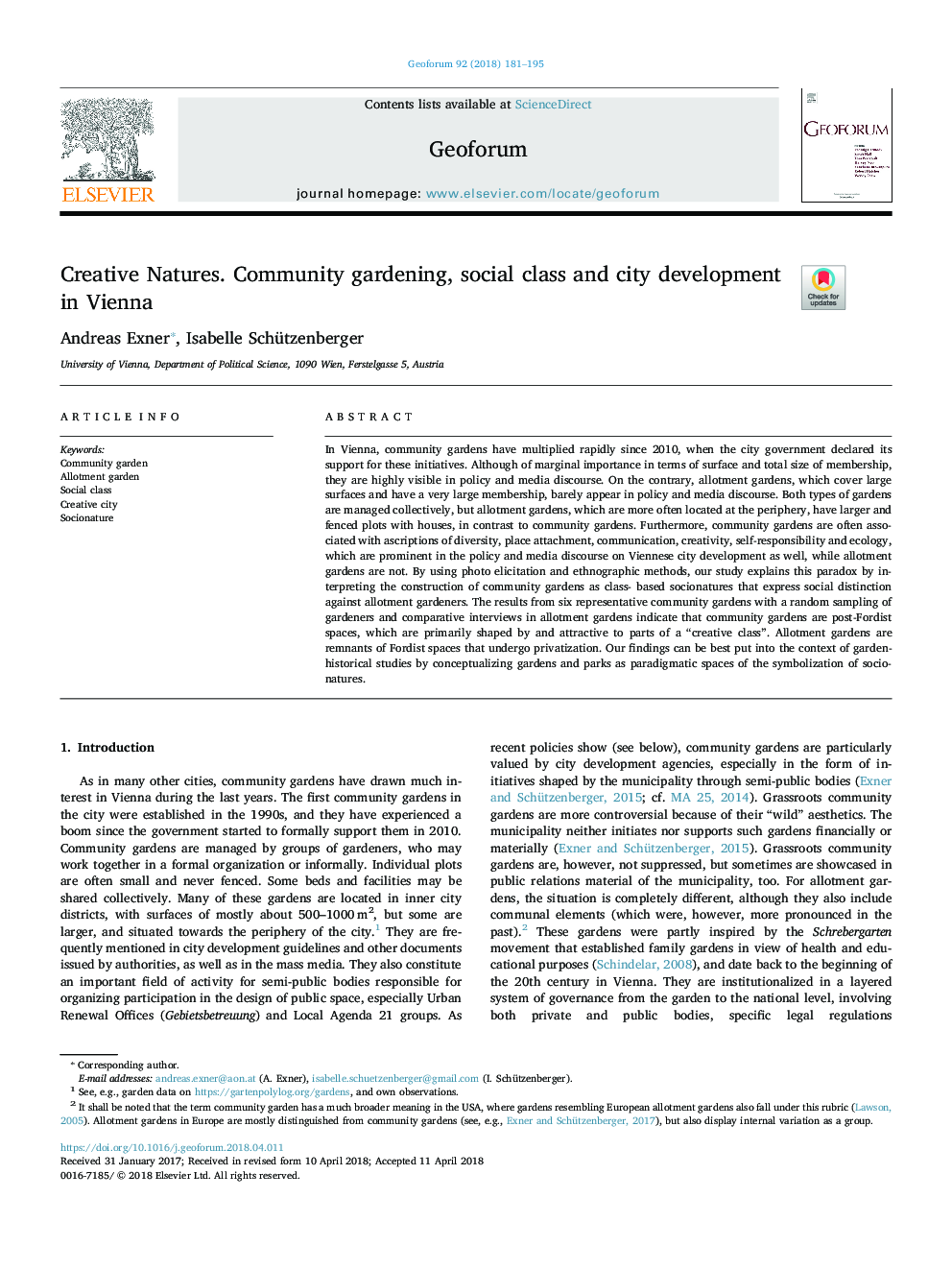| کد مقاله | کد نشریه | سال انتشار | مقاله انگلیسی | نسخه تمام متن |
|---|---|---|---|---|
| 7353620 | 1477097 | 2018 | 15 صفحه PDF | دانلود رایگان |
عنوان انگلیسی مقاله ISI
Creative Natures. Community gardening, social class and city development in Vienna
ترجمه فارسی عنوان
طبیعت خلاقانه باغبانی اجتماعی، طبقه اجتماعی و توسعه شهر در وین
دانلود مقاله + سفارش ترجمه
دانلود مقاله ISI انگلیسی
رایگان برای ایرانیان
ترجمه چکیده
در وین، باغ های محلی به سرعت از سال 2010 افزایش می یابد، زمانی که دولت شهر حمایت خود را از این ابتکارات اعلام کرد. گرچه اهمیت لایحه در سطح و سطح عضویت، آنها در گفتمان سیاست و رسانه بسیار قابل مشاهده است. برعکس، باغ های اختصاص داده شده، که سطوح زیادی را پوشش می دهند و عضویت بسیار زیادی دارند، به سختی در گفتمان سیاسی و رسانه ای ظاهر می شود. هر دو نوع باغ ها به طور دسته جمعی مدیریت می شوند، اما باغ های اختصاصی که اغلب در حاشیه قرار دارند، در مقایسه با باغ های محلی، دارای تپه های بزرگتر و حیاطی با خانه هستند. علاوه بر این، باغ های محلی اغلب با عناوین تنوع، دلبستگی، پیوند، خلاقیت، خود مسئولیت و محیط زیست همراه هستند، که در سیاست و گفتمان رسانه ای در توسعه شهر وین نیز مشهود است، در حالی که باغ های اختصاصی وجود ندارد. با استفاده از روش های عکسبرداری و روش های قوم نگاری، مطالعه ما این تفکر را با تفسیر ساخت باغ های محلی به عنوان جوامع طبقاتی طبقه بندی می کند که تمایز اجتماعی را نسبت به باغداران تخصیص نشان می دهد. نتایج حاصل از شش نمایندگی باغ های با نمونه گیری تصادفی از باغبان و مصاحبه های مقایسه ای در باغ های اختصاص داده شده نشان می دهد که باغ های محلی فضاهای پس از فروید است که در درجه اول به شکل و جذاب به بخش هایی از کلاس های خلاقانه است. باغ های اختصاص داده شده، بقایای فضاهای فوردیست هستند که خصوصی می شوند. یافته های ما می تواند در زمینه مطالعات تاریخی باغی با مفهوم سازی باغ ها و پارک ها به عنوان فضاهای پارادایم آمیز نماد سازی جوامع در نظر گرفته شود.
موضوعات مرتبط
علوم انسانی و اجتماعی
اقتصاد، اقتصادسنجی و امور مالی
اقتصاد و اقتصادسنجی
چکیده انگلیسی
In Vienna, community gardens have multiplied rapidly since 2010, when the city government declared its support for these initiatives. Although of marginal importance in terms of surface and total size of membership, they are highly visible in policy and media discourse. On the contrary, allotment gardens, which cover large surfaces and have a very large membership, barely appear in policy and media discourse. Both types of gardens are managed collectively, but allotment gardens, which are more often located at the periphery, have larger and fenced plots with houses, in contrast to community gardens. Furthermore, community gardens are often associated with ascriptions of diversity, place attachment, communication, creativity, self-responsibility and ecology, which are prominent in the policy and media discourse on Viennese city development as well, while allotment gardens are not. By using photo elicitation and ethnographic methods, our study explains this paradox by interpreting the construction of community gardens as class- based socionatures that express social distinction against allotment gardeners. The results from six representative community gardens with a random sampling of gardeners and comparative interviews in allotment gardens indicate that community gardens are post-Fordist spaces, which are primarily shaped by and attractive to parts of a “creative class”. Allotment gardens are remnants of Fordist spaces that undergo privatization. Our findings can be best put into the context of garden- historical studies by conceptualizing gardens and parks as paradigmatic spaces of the symbolization of socionatures.
ناشر
Database: Elsevier - ScienceDirect (ساینس دایرکت)
Journal: Geoforum - Volume 92, June 2018, Pages 181-195
Journal: Geoforum - Volume 92, June 2018, Pages 181-195
نویسندگان
Andreas Exner, Isabelle Schützenberger,
